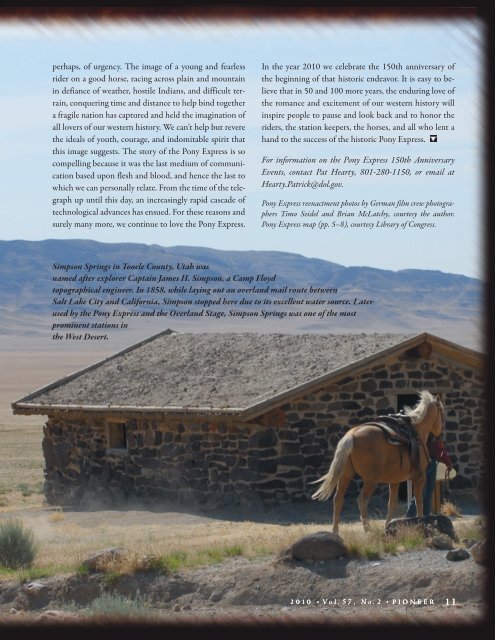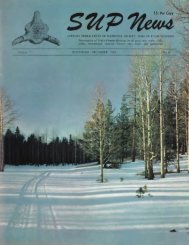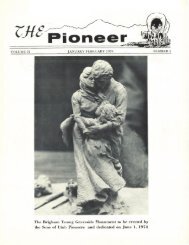Create successful ePaper yourself
Turn your PDF publications into a flip-book with our unique Google optimized e-Paper software.
perhaps, of urgency. The image of a young and fearless<br />
rider on a good horse, racing across plain and mountain<br />
in defiance of weather, hostile Indians, and difficult terrain,<br />
conquering time and distance to help bind together<br />
a fragile nation has captured and held the imagination of<br />
all lovers of our western history. We can’t help but revere<br />
the ideals of youth, courage, and indomitable spirit that<br />
this image suggests. The story of the Pony Express is so<br />
compelling because it was the last medium of communication<br />
based upon flesh and blood, and hence the last to<br />
which we can personally relate. From the time of the telegraph<br />
up until this day, an increasingly rapid cascade of<br />
technological advances has ensued. For these reasons and<br />
surely many more, we continue to love the Pony Express.<br />
In the year <strong>2010</strong> we celebrate the 150th anniversary of<br />
the beginning of that historic endeavor. It is easy to believe<br />
that in 50 and 100 more years, the enduring love of<br />
the romance and excitement of our western history will<br />
inspire people to pause and look back and to honor the<br />
riders, the station keepers, the horses, and all who lent a<br />
hand to the success of the historic Pony Express.<br />
For information on the Pony Express 150th Anniversary<br />
Events, contact Pat Hearty, 801-280-1150, or email at<br />
Hearty.Patrick@dol.gov.<br />
Pony Express reenactment photos by German film crew photographers<br />
Timo Seidel and Brian McLatchy, courtesy the author.<br />
Pony Express map (pp. 5–8), courtesy Library of Congress.<br />
Simpson Springs in Tooele County, Utah was<br />
named after explorer Captain James H. Simpson, a Camp Floyd<br />
topographical engineer. In 1858, while laying out an overland mail route between<br />
Salt Lake City and California, Simpson stopped here due to its excellent water source. Later<br />
used by the Pony Express and the Overland Stage, Simpson Springs was one of the most<br />
prominent stations in<br />
the West Desert.<br />
<strong>2010</strong> Vol. 57, <strong>No.2</strong> PIONEER 11<br />
◆ ◆







